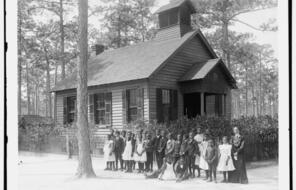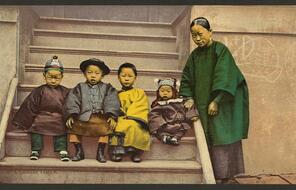Doors to Opportunity
At a Glance
Language
English — USSubject
- History
- Racism
Progressives believed in the power of education to “civilize,” “uplift,” and “Americanize.” In every state in the nation, they lobbied for laws that required children to attend school until at least the age of 14. Partly as a result of their efforts, school enrollment in the United States increased by more than 600 percent, from about 200,000 students in 1880 to over 1.5 million by 1920.
Yet even as progressive reformers worked to expand educational opportunities, many were uncertain that all children could benefit from schooling. Increasingly some argued that education should be made available only to those with a large “endowment” of certain qualities like “character, disposition, energy, intellect, or physical power”—qualities that “go towards the making of civic worth.” They insisted that placing children (based on race, class, or gender) in the right educational “track” or even in a special school to train them for their “rightful place” in society was the most efficient use of taxpayers’ money.
The experiences of two young immigrants reveals how race shaped the kind of education available to many Americans in the late 1800s. Mary Antin, a young Jewish immigrant from Poland, came to Boston with her mother and siblings in 1894. They reunited with Antin’s father who had arrived earlier to find a job and establish a home. She writes in her autobiography:
Education was free. That subject my father had written about repeatedly, as comprising his chief hope for us children, the essence of American opportunity, the treasure that no thief could touch, not even misfortune or poverty. It was the one thing that he was able to promise us when he sent for us, surer, safer, than bread or shelter. On our second day [in America] I was thrilled with the realization of what this freedom of education meant. A little girl from across the alley came and offered to conduct us to school. My father was out, but we five [children] between us had a few words of English by this time. We knew the word school. We understood. This child, who had never seen us till yesterday, who could not pronounce our names, who was not much better dressed than we, was able to offer us the freedom of the schools of Boston! No application made, no questions asked, no examinations, rulings, exclusions; no machinations, no fees. The doors stood open for every one of us. The smallest child could show us the way. This incident impressed me more than anything I had heard in advance of the freedom of education in America. It was a concrete proof—almost the thing itself. One had to experience it to understand it. 1
Ten years before the Antins came to the United States, another immigrant family tried to enroll their daughter at a public school in San Francisco only to be turned away. Principal Jennie Hurley explained that the Board of Education did not allow children of Chinese descent to attend the city’s public schools. In 1884, the Tapes sued the principal in a case known as Tape v. Hurley for denying Mamie, their 8-year-old daughter, an education. Hurley and other school officials defended the child’s exclusion by pointing to a clause in the California constitution describing the Chinese as “dangerous to the well-being of the state.” Therefore, they argued, the city was not obligated to educate the Chinese. Despite the school board’s argument, the courts ruled in the Tapes’ favor, citing a state law requiring that “all children” be admitted to school; only “children of filthy or vicious habits,” or “children suffering from contagious or infectious diseases” could be excluded. Mamie Tape had the “same right to enter a public school” as any other child. Officials responded to the ruling by establishing a special public school just for Mamie Tape and any other Chinese child who wished to attend. Outraged, Mary Tape, young Mamie’s mother, wrote a letter in newly learned English to the Board of Education in April of 1885:
DEAR SIRS: I see that you are going to make all sorts of excuses to keep my child out of the Public Schools. Dear sirs, Will you please to tell me! Is it a disgrace to be Born a Chinese? Didn’t God make us all!!!! What right have you to bar my children out of the school because she is a Chinese Decend. There is no other worldly reason that you could keep her out, except that. I suppose, you all goes to church on Sundays! Do you call that a Christian act to compel my little children to go so far to a school that is made on purpose for them. My children don’t dress like the other Chinese. They look just as phunny amongst them as the Chinese dress in Chinese look amongst you Caucasians. Besides, if I had any wish to send them to a Chinese school I could have sent them two years ago without going to all this trouble. You have expended a lot of Public money foolishly, all because of one poor little Child. Her playmates is all Caucasians ever since she could toddle around. If she is good enough to play with Them! Then is she not good enough to be in the same room and study with them? You had better come and see for yourselves. See if the Tapes is not the same as other Caucasians except in features. It seems not matter a Chinese may live and dress so long as you know they Chinese. Then they are hated as one. There is not any right or justice for them.
You have seen my husband and child. You told him it wasn’t Mamie Tape you object to. If it were not Mamie Tape you object to, then why didn’t you let her attend the school nearest her home! Instead of first making one pretense of some kind to keep her out? It seems to me Mr. Moulder has a grudge against this Eight-year-old Mamie Tape. I know they is no other child I mean Chinese child! Care to go to your public Chinese school. May you Mr. Moulder, never be persecuted like the way you have persecuted little Mamie Tape. Mamie Tape will never attend any of the Chinese schools of your making! Never!!! I will let the world see sir What justice there is When it is govern by the Race prejudice men! Just because she is of the Chinese decend, not because she don’t dress like you because she does. Just because she is decended of Chinese parents I guess she is more of a American than a good many of you that is going to prevent her being Educated. 2
School officials ignored Mary Tape’s appeal. So did the California courts. At the turn of the 20th century, both state and federal courts supported the idea of “separate but equal” schools for children of “inferior races.” Mamie Tape had to attend a segregated school or not be educated at all.
In 1906, San Francisco school officials decided to send students of Japanese and Korean descent to Mamie Tape’s school. Over 1,200 Japanese parents in the city responded to the announcement with a lawsuit attacking segregation. The Japanese consul in California wrote a formal letter of protest to government officials in Washington, D.C. President Theodore Roosevelt, eager to maintain good relations with Japan, sent a member of his cabinet to San Francisco to encourage the school board to withdraw its order. Although the Japanese were pleased with Roosevelt’s stand, San Francisco school officials were unimpressed. In the end, however, they agreed to a political compromise. The city would allow Japanese children to attend all-white schools if the federal government sharply limited the number of Japanese laborers who could enter the United States each year. In the years that followed, those limits were tightened further so that fewer and fewer Japanese immigrants could settle in the nation.
How to Cite This Reading
Facing History & Ourselves, “Doors to Opportunity,” last updated September 16, 2022.
This reading contains text not authored by Facing History & Ourselves. See footnotes for source information.












